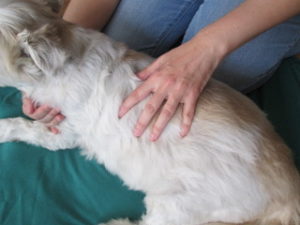A look at how massage therapy can help ease anxiety in companion animals, and some tips on how to try it at home!
Anxiety is a feeling of worry. The associated nervousness or unease is typically linked to either an imminent event or an uncertain outcome. Our fur babies can experience anxiety for any number of fear-based reasons—from changes in their routine to visual stimuli – and it can worsen as they age. Touch through massage therapy is a comforting one-on-one experience that creates a sense of trust, relaxation, and well-being, and is a great way to help anxious dogs and cats.
How does it work?
Massage works in a number of different ways to ease anxiety in pets. On a very basic level, the soothing strokes help improve the animal’s mood and mental state. This is important for a number of physical reasons as well. The mental state of an animal affects the sympathetic nervous system, so massage therapy works to reduce heart rate and blood pressure.
Massage therapy reduces both the physical and mental components of stress, which in turn helps the body feel balanced and rejuvenated. Once stress is reduced, illnesses that would otherwise gain a foothold due to the body’s diminished immune system can be more effectively fought off.
For pets experiencing the stress of recovering from an injury or those in emotional distress from being in the shelter system, mental state is key. Massage therapy stimulates the release of oxytocin, serotonin and endorphins – feel-good hormones that are critical to rehabilitation. Massage also helps to manage pain, therefore alleviating the associated depression and/or anxiety a pet might experience after physical trauma.
Massage strokes to try at home
With the consent of your veterinarian, there are a couple of massage strokes you can perform on your pet in the comfort of your own home to help relieve his anxiety. First, you’ll want to make sure he doesn’t have any contraindications to massage, which is why connecting with your vet is crucial. Contraindications may include acute pain and/or inflammation, cancer, circulation problems, dermatological conditions, diabetes, epilepsy, fever, heart conditions and pregnancy.
Once you have the official go-ahead from your vet, you can try the following strokes on your pet:

Effleurage
Use your palm while keeping your fingers together and slightly raised, and move down along the lay of the fur and in the direction of the heart, using a gentle pressure and slow speed. Effleurage helps to increase circulation, which will help deliver nutrients more efficiently to ligaments, tendons, bones, and all the joints, therefore keeping the joints well lubricated.

Raking
Raking is similar to effleurage except that the fingers are splayed and the pressure is in the fingertips. Since raking is a stronger stroke, you’ll be able to get deeper into the muscle tissue to help ease tired muscles. This technique is good for muscles that are compensating for weakness elsewhere in the body! You can also use this stroke through the chest/pectoral muscles.
Visit kurik9massage.com/home-care.html for more information, including the most effective areas of the body to use these strokes, and some dos and don’ts.
With any luck, you, your veterinarian and a small animal massage therapist can work together to help your anxious pet find relief through the comfort and healing massage therapy provides!








